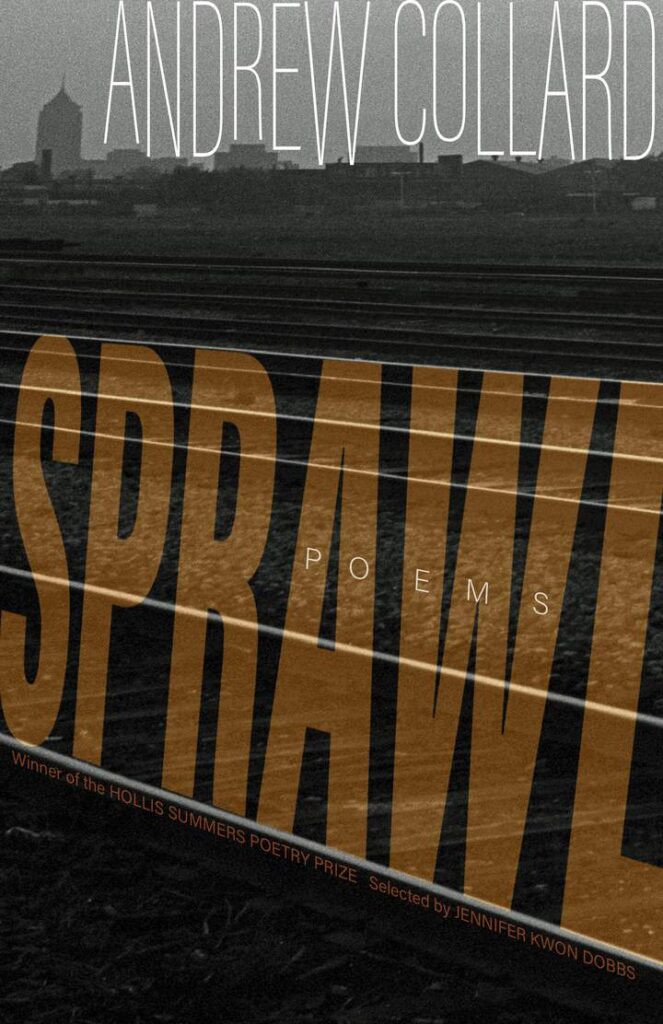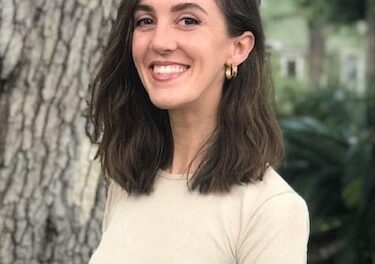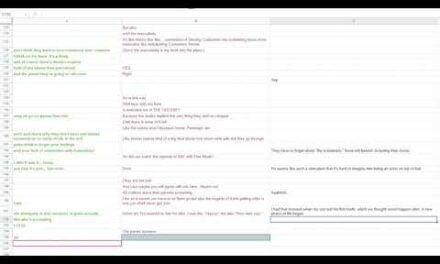Associate Editor Connor Yeck: This week on the blog I’m especially excited to turn things over to CR contributors, friends, and fellow Michiganders Dennis Hinrichsen and Andrew Collard, who have two new poetry collections launching this March. Andrew’s poem “Gas & Food” appeared in our Issue 18.1, and Dennis’s “[Pastoral] [w/a Bee Sting in It & the City of Florence]” was included in last spring’s Issue 19.1. Keep reading to hear Andrew reflect on his debut, Hollis Summers Prize-winning collection Sprawl in conversation with Dennis (and take a listen to the book’s accompanying playlist!) Stay tuned for part two of the series, in which Andrew speaks with Dennis about his latest collection Flesh-plastique, on Thursday,

Dennis Hinrichsen: Sprawl is such a wonderful book to consider as a psychogeographical mapping of the greater Detroit area. I wonder if you could speak to the formal gesture of the book—I love how the opening poem collapses scene to a diorama, to set up the run of similar gestures in the sections, all set against the Sterling Assembly Plant interludes, which feel cut from different cloth. I’m curious as to how those interludes inform the vision at work in the poems as well as the overall structure of the book.
Andrew Collard: It’s all about “the way the pieces move,” as “Diorama” says. I rode the highways around and through Detroit hundreds of times as a kid but realized only later that they were built over neighborhoods. The Sterling Assembly Plant interludes were an exercise in restoring historical context to the various neighborhoods, diners, roadsides, etc, that appear throughout the book. The interludes appear in a collaged-in manner because the information really appeared that way to me—having grown up in the area, I knew the building, but never knew what it was. Two of them are built on interviews done by the Detroit Free Press when the plant started making Redstone missiles in the 1950s, and one recycles language from a report on the environmental impacts of the nuclear tests in the Pacific where the missiles were used. And this is only one plant in one particular suburb! This sort of history exerts continuing pressure on the people living in Metro Detroit in the present, even if it’s sometimes hard to see.
Bringing actual documentation into the book also adds a polyvocal quality that I think is necessary to my larger project in connecting up my own experience to what’s happening socially and culturally.
DH: Lawrence Joseph blurbs Sprawl and immediately feels like one of perhaps many influences for the book. What are some of the other poets and books that guided this project as it came together? Also, do you see yourself writing out of a particular tradition that argues for a role for poetry beyond the limited personal lyric?
AC: It’s hard to answer this without it becoming a list! Joseph’s book So Where Are We? (Farrar, Straus and Giroux, 2017) was a particularly resonant influence on what I see as Sprawl’s core poems in terms of musicality and the way Joseph captures the experience of the physical world, with waves of sensory input and information constantly washing over us. In terms of contemporary books, Jamaal May’s Hum (Alice James, 2013) and francine j. harris’s allegiance (Wayne State University Press, 2012) have been there since more or less the beginning of the project, both featuring a Midwest I recognized and could locate myself in.
I’ve been involved in a long-term study of American poets of the 1930s and ’40s who are alternately grouped as “social poets,” “proletarian poets,” or simply as left-wing modernists. This started with Muriel Rukeyser and Langston Hughes and quickly led me to Kenneth Fearing, all of whom write in mixed registers and often investigate specific sites of memory, and all of whom have deeply impacted my approach. A lot of records, comic books, and theoretical works in there also. Neil Young is almost a supporting character.
I tend to think that structure produces content and that structure in poetry is deeply entwined with the body and physical experience. “Punctuation is biological,” Rukeyser says. So in answer to your second question, I guess I would say “yes.” (laughs)
DH: Terrific, the Rukeyser quote leads me into my next question about “punctuation,” or more broadly the formal imagination at work in Sprawl. By that, I don’t mean working with traditional forms but working more with “biological” broken forms, invented forms, found forms, even cutting in ideas about cinema and graphic design. So I’m intrigued by those poems of yours that challenge the right-hand margin and use interior white space, as well as your ideas about the sentence, which always feels very composed to me and maps across that white space down the page. I tried using it with disastrous results. The form feels totally yours, very Collard-esque. Could you talk about its genesis and how it works as a formal gesture?

AC: Sure! I might say right off the bat that I don’t think of the mid-line spaces in terms of “white space” or physical page space at all, but simply as particular kinds and lengths of pauses in the line. I started using them after reading a lot of Paterson and triad-era William Carlos Williams and then Adrienne Rich, who often uses those kinds of pauses, and thinking about what a variable foot might look like. Rich’s usage in poems like “Power” seemed to point to one answer to that question. Ultimately the mid-line spaces are a form of punctuation just as line breaks are, to be used when other forms of punctuation aren’t precise enough. They allow me both to be truer to and to riff away from my ingrained patterns of diction and syntax.
I also see this kind of spacing as deeply related to the drop-line (aka the Charles Wright lowrider) and the descending tercet, both of which allow useful measures of suspension within the sentence. The Rukeyser quote, to me, emphasizes the idea that our experience of language is tied directly to the conditions we live in, and as both my sense of language and my sense of self are always shifting, I feel like I am constantly after ways of discovering their music.
DH: I can’t help but get a dystopian vibe from your book given the title and William Gibson’s Sprawl trilogy out there. So your book feels proto-cyberpunk to me—a perpetual movement via cars, often through ideas of memory and place and the layered ruins progress makes of place, all of it underwritten by the substrate of nuclear violence we read in the Sterling Assembly Plant interludes. How do you see memory and place operating in these poems, and how do they connect to the idea of aloneness that is a repeated theme in book?
AC: The book’s not meant to be dystopian or cyberpunk at all, and I’m not a big reader of those types of stories, though I find some of Gibson’s terminology useful. Sprawl is just a response to my own circumstances. So, it’s a book about being a parent and living in a constant state of emergency, and about cars and labor and the ways places and people relate to each other. Nothing that happens is happening in a vacuum. I think society is set up in a way that is meant to isolate us from other people and even from our own actions and memories. Memory and place are more or less what we’re made of, so maybe we can use them.
DH: What I love about Sprawl is that it feels note perfect to me—intricately designed—fully realized—not a false move anywhere. Like one of those amazing first albums some bands manage that come out of a long foregrounding and lay down a kind of challenge for the next. So I’m curious: How did you evolve as a writer to get to this stage? And then: What’s next for you? What lines of thought laid down here are you going to follow?
AC: Thank you! My interests change constantly and my process is pretty fragmented because of the way my life is and has been. I had titles and notes for “Telway Lament” and “Quizzo Night at the Red Ox” in a tiny notebook back in 2013 but didn’t actually have full drafts of either until years later. While ideas for some of the poems date back a ways, the core of the book started coalescing around 2018 when the “Autotopia” sequence came together, and the musicality of those poems started to bleed into the others. Originally, “Autotopia” was the book title. Those poems really opened things up in terms of what I’m aiming for and what I thought was possible. Before that I was relying a lot more on straightforward narrative strategy and various rhetorical devices, not that those have disappeared. If anything, though, that sense of song and vision is what I want to continue following. Not so much a line of thought as a line of feeling.

Sprawl Playlist:
1. “Kick Out the Jams” by MC5
2. “A Million Parachutes” by Sixpence None the Richer
3. “Good Life” by Inner City
4. “Expecting to Fly” by Buffalo Springfield
5. “Surf’s Up” by The Beach Boys
6. “Fifty Years After the Fair” by Aimee Mann
7. “Badlands Flashback” by Bruce Cockburn
8. “Take Me with U” by Prince
9. “Germfree Adolescence” by X-Ray Spex
10. “Walk Away Renee” by Four Tops
Andrew Collard is the author of Sprawl (Ohio University Press, 2023), winner of the Hollis Summers Poetry Prize. His poems have appeared in Ploughshares, AGNI, Best New Poets, and elsewhere. He currently lives in Grand Rapids, Michigan, with his son, where he teaches writing at Grand Valley State University.
Flesh-plastique is Dennis Hinrichsen’s tenth book of poetry. His previous books include schema geometrica (Wishing Jewel Poetry Prize; Green Linden Press, 2021) and This Is Where I Live I Have Nowhere Else To Go (Grid Poetry Prize; 2020). His other awards and prizes include a Best of the Net selection and the Third Coast Poetry Prize, as well as the Akron, FIELD, Tampa, and Michael Waters Poetry Prizes. He has new work appearing or forthcoming in diode, The Glacier, The Pedestal, and Timber. He lives in Lansing, Michigan, where he does freelance workshops.










